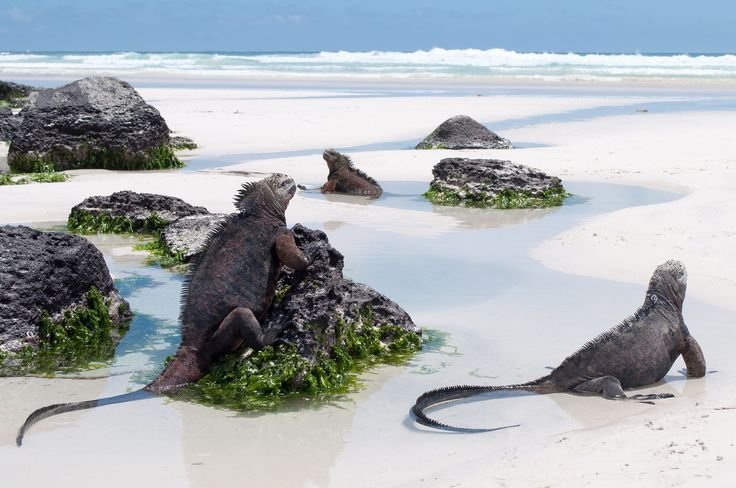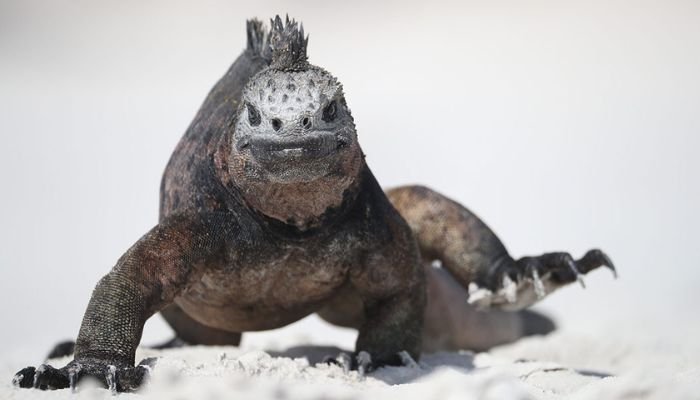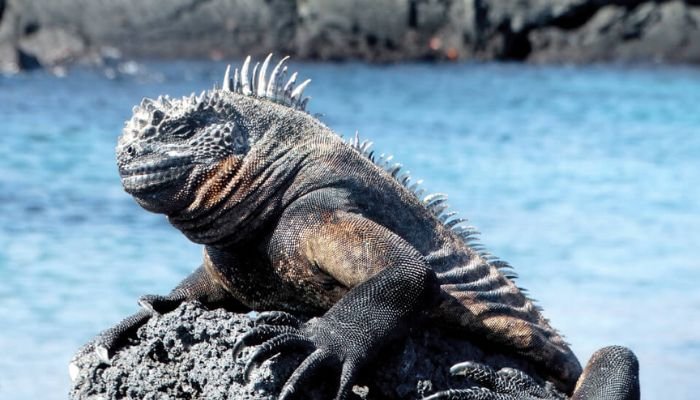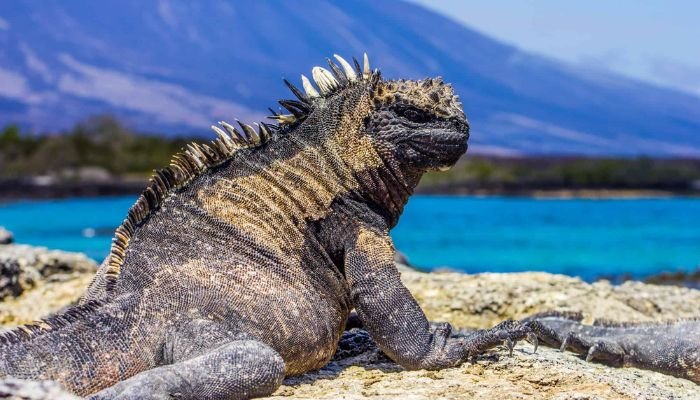
The Galapagos Marine Iguana is a unique and peculiar variety of reptile found only in the Galapagos Islands. Only this species of iguana is capable of oceanic foraging and swimming. Marine iguanas have evolved powerful claws, a flattened tail, and the ability to expel excess salt through specialized nasal glands, to name a few of their unique adaptations. These iguanas are specialized herbivores that ingest primarily seaweed and algae. Due to its remarkable adaptations and habits, the Galapagos Marine Iguana is a captivating species to observe and study.. Here are Galapagos marine iguana Guide on Food, Habitat, Size, Lifespan & Predators below-
Galapagos Marine Iguana Stats in Table format
The stats are given below for Galapagos marine iguana
| Reptiles List | Galapagos marine iguana |
|---|---|
| Family | Iguanidae |
| Type | Lizard |
| Size | Medium to Large |
| Length | Galapagos marine iguana: Up to 3-5 feet (0.9-1.5 meters) |
| Color | Galapagos marine iguana: The color varies depending on the age and location, but Galapagos marine iguanas can have shades of black, gray, or brown. |
| Weight | Galapagos marine iguana: Can weigh between 3 to 10 pounds.. |
| Lifespan | 5-20 years (or more) |
| Reproduction | Oviparous, lays eggs |
| Gestation Periods | The gestation period for Galapagos marine iguanas is approximately 90 to 120 days. |
| Endangered Status | Vulnerable (IUCN Red List) |
| Features | Flattened body, specialized snout for feeding on marine algae |
| Country & Areas | Ecuador, Galapagos Islands |
Galapagos Marine Iguana Natural Habitat and Distribution
Amblyrhynchus cristatus, or the Galapagos marine iguana, is endemic to the Galapagos Islands, a group of volcanic islands in the Pacific Ocean about 1,000 kilometers (620 miles) from the coast of Ecuador in South America. Each island in the Galapagos archipelago presents its own unique mix of problems and resources, and thus each of these remarkable critters has evolved to make the most of its own home.
Marine iguanas like to sun themselves in the equatorial regions, thus you can find them lounging on lava fields, rocky shores, and intertidal zones. Because of their semiaquatic adaptations, they tend to live in coastal areas, as their name suggests. This adaptation makes it possible for them to hunt for food in the ocean and then retreat to land to cool off.
Galapagos Marine Iguana Physical Features and Adaptations
In the below section, we will provide some other information on Galapagos Marine Iguana:-
Body Structure
The marine iguanas of the Galapagos Islands seem different from any other iguana species. They average between 20 and 30 inches (50 and 76 centimeters) in length, which is somewhat short compared to their terrestrial kin. They are fast swimmers in the water due to their streamlined physique, making them great divers.
Coloration and Patterns
These iguanas come in a wide variety of colors, from black and gray to reddish brown. During the breeding season, adult marine iguanas’ darker coloring improves their ability to absorb and retain heat. Iguanas are already fascinating creatures, but the fact that some islands are home to iguanas with unusual color morphs just adds to their allure.
Defense Mechanisms
To protect themselves from the dangerous conditions of the Galapagos, marine iguanas have developed a variety of strategies. Unique to this species is the ability to discharge salt from glands near the nasal passages when they feel threatened. This action, commonly referred to as “sneezing,” allows them to expel the salt they consume when eating sea algae.

Galapagos Marine Iguana Diet and Feeding Habits
In the below section, we will provide some other information on Galapagos Marine Iguana:-
Diet Type
The Galapagos marine iguana, the world’s only known marine lizard, subsists exclusively on marine algae, particularly the red, green, and brown algae that may be found along the shores of the Galapagos Islands. Because of this adaptation, they are able to thrive in a way that no other iguana species can.
Preferred Food Sources
Marine iguanas love to snack on the seaweed that grows in the calm waters off the islands. They come out to the ocean at low tide to feed on the algae, taking advantage of the greater food supply and the increased nutrient content of the underwater flora.
Feeding Schedule
The marine iguana of the Galapagos Islands adapts its feeding schedule to the changing tides. They plan their foraging trips such that they occur at low tide, when the marine flora is more accessible. They come back to land after a feeding session to digest the nutrient-rich algae and warm themselves.
Galapagos Marine Iguana Housing and Enclosure Requirements
In the below section, we will provide some other information on Galapagos Marine Iguana:-
Terrarium Size and Setup
Because of their status as a protected species, Galapagos marine iguanas cannot be owned as pets or kept in captivity without special permission from the government. They need both land and water in their natural environment, with rocks for basking and sand for nesting.
Substrate Options
When marine iguanas are in their natural habitat, they lay their eggs on sandy places. In captivity, however, it is essential to provide a substrate consisting of a combination of sand and rocks to permit basking and nesting habits, much as they would in the wild.
Temperature and Lighting
Marine iguanas are ectothermic, meaning they use their surroundings to maintain a constant internal temperature. Thermoregulation can be aided in captivity by providing a temperature gradient and basking areas bathed in full-spectrum lights to mimic natural sunlight.
Humidity and Water Needs
Semiaquatic and spending much of its time in the ocean, the Galapagos marine iguana still requires a freshwater source for drinking, soaking, and swimming in its captive cage. The enclosure should have humidity levels analogous to those seen on the Galapagos Islands.

Galapagos Marine Iguana Behaviour and Temperament
In the below section, we will provide some other information on Galapagos Marine Iguana:-
Activity Levels
Galapagos marine iguanas’ levels of activity shift throughout the day and with the seasons. In the early morning, when the tide is low, they venture into the water to graze on algae. They use the time in the sun after a meal to digest and get warmed up.
Social Behaviour
These lizards are notable for their communal lifestyle, since vast colonies can be found on specific islands. Male marine iguanas are known to become aggressive and territorial during the mating season.
Handling and Taming
It cannot be stressed enough that marine iguanas in the Galapagos are a protected species that must never be approached or attempted to be domesticated. Interfering with these animals might throw off their natural habits and upset the fragile ecological balance.
Galapagos Marine Iguana Breeding and Reproduction
In the below section, we will provide some other information on Galapagos Marine Iguana:-
Mating and Courtship Rituals
During the cold and dry season, when food is plentiful, the Galapagos marine iguanas have their breeding season. To woo potential mates, males will perform elaborate courtship displays, such as head bobbing and body motions. To protect their territories, dominant males will mate with several females.
Incubation and Hatchlings
Female marine iguanas, after mating, deposit their eggs on the sand along the coast. The eggs require between 90 and 120 days of incubation time in the warm sand before they hatch. The young birds migrate to the ocean on autopilot, but they must brave several dangers along the route.
Galapagos Marine Iguana Common Health Issues and Veterinary Care
In the below section, we will provide some other information on Galapagos Marine Iguana:-
Respiratory Infections
Marine iguanas are susceptible to respiratory illnesses, especially in poorly controlled captivity conditions involving temperature and humidity. Nasal discharge, trouble breathing, and wheezing are all possible symptoms. Visits to the veterinarian on a regular basis can help detect and treat these conditions early.
Parasites:
Internal and external parasites are a problem for marine iguanas, just as they are for many other reptiles. Their health and ability to feed efficiently can be negatively impacted by these pests.
Metabolic Bone Disease
Captive reptiles, notably marine iguanas, often suffer from metabolic bone disease. Bone weakness and abnormalities can occur when vitamin D3 levels are low relative to calcium levels.

Importance of Regular Vet Check-ups
The health of Galapagos marine iguanas, especially captive ones, depends on regular visits from a veterinarian. A trained vet can check on their health, give advice on how to care for them, and treat any problems as soon as they arise.
Conclusion:
The marine iguana of the Galapagos is a noteworthy reptile because of the wide variety of adaptations it has developed to survive in its specific island environment. Its uniqueness as the only marine lizard in the world highlights the incredible biodiversity and evolutionary processes at work in the Galapagos.
Its unique food, semiaquatic nature, and curious habits serve as a symbol for the need to protect the unusual wildlife and delicate ecology of the Galapagos. Although their allure may pique the interest of reptile fans, it is essential to keep in mind that these animals are protected and must be left alone in their native environment so that future generations can also enjoy their wonders.
FAQs
Q: What is the family and Type of an Galapagos marine iguana?
A: The Galapagos marine iguana is a species of family Iguanidae. The Famous Galapagos marine iguana is a member of the family Lizard.
Q: What is the average size of a Galapagos marine iguana?
A: The average adult Galapagos marine iguana is Medium to Large between Galapagos marine iguana: Up to 3-5 feet (0.9-1.5 meters).
Q: How long can a Galapagos marine iguana grow in size in lengths?
A: Galapagos marine iguana is Medium to Large in size and The Galapagos marine iguana can grow to be as long as 3-5 feet (0.9-1.5 meters).
Q: What colors do Galapagos marine iguana come in?
A: The color of Galapagos marine iguanas can vary depending on their age and where they are found. These fascinating creatures can display shades of black, gray, or brown..
Q: How big can a Galapagos marine iguana get in weight?
A: The Galapagos marine iguana is a fascinating creature that can range in weight from 3 to 10 pounds.
Q: What are the special Features of a Galapagos marine iguana?
A: Galapagos marine iguana are Flattened body, and specialized snouts for feeding on marine algae
Q: How long do Galapagos marine iguana live?
A: The usual lifespan of a Galapagos marine iguana is The Galapagos marine iguana has a lifespan of approximately 5-20 years, although some individuals may live even longer.
Q: What food does the Galapagos marine iguana eat?
The Galapagos marine iguana relies heavily on seaweed and algae for sustenance. Their capacity to dive deep into the ocean to hunt for food sets them apart. They get the nutrition they need to endure their extreme environment from a diet of red and green algae. As herbivores, they have shifted their diet to focus primarily on aquatic plants.
Q: What is the best habitat for a Galapagos marine iguana?
The Galapagos marine iguana thrives along the rocky coasts and sandy beaches of the Galapagos Islands. Because no other lizards live in the ocean, marine iguanas are truly one-of-a-kind creatures. They can only survive in the Pacific Ocean’s frigid, nutrient-rich waters. They can get some much-needed sun and be safe from potential predators on the rocky shoreline. The females lay their eggs in the sand of the beaches, making them vital for the process of reproduction. As with sea turtles, marine iguanas rely heavily on the intertidal zone’s algae for sustenance. Because of the unique coastline features and marine ecosystem of the Galapagos Islands, the Galapagos marine iguana has found its ideal home there.
Q: How do Galapagos marine iguana give birth?
A: Galapagos marine iguanas are Oviparous, lays eggs
Q: How long is the gestation period for a Galapagos marine iguana?
A: The gestation period of a Galapagos marine iguana is approximately The gestation period for Galapagos marine iguanas is approximately 90 to 120 days.
Q: What is the natural behavior of a Galapagos marine iguana?
Most marine iguanas in the Galapagos are The Galapagos marine iguana is predominantly a sea animal in its natural habitat. They’re the only kind of lizard that can actually swim in the water. They devote a great deal of time to swimming around and diving for food. They have also been observed warming themselves by sunbathing on stony coasts. Because of their sociable nature, these iguanas often congregate in huge numbers, particularly during mating season. To assert authority and woo potential mates, males will often engage in territorial displays and battles. Well adapted to their environment, they have glands that allow them to rid themselves of excess salt. The marine iguana of the Galapagos Islands is a notable species because of its extraordinary adaptations to a marine environment.
Q: Is the Galapagos marine iguana endangered?
A: The Galapagos marine iguana is Vulnerable (IUCN Red List).
Q: What are the prey of Galapagos marine iguana?
The Galapagos marine iguana feeds mostly on marine vegetation such as algae and seaweed. Herbivorous reptiles, they subsist mostly on the intertidal zone flora. Their teeth and jaws have adapted to their habitat such that they may scrape algae off rocks and eat it. The marine iguanas’ food consists primarily of fish, however, they do supplement this with small invertebrates like crabs and mollusks.
Q: Do Galapagos marine iguana have any Predators?
A: Galapagos marine iguana have The predators of the Galapagos marine iguana include sharks, such as the Galapagos shark and the tiger shark, as well as large predatory fish like the yellowfin tuna. Additionally, birds like the Galapagos hawk and the peregrine falcon are known to prey on the marine iguanas. These predators pose a threat to the survival of the marine iguana population, especially during their vulnerable stages, such as when they are swimming or basking on the rocks..
Q: How Fast Does Galapagos marine iguana Move?
A: The Galapagos marine iguana can move at speeds of up to 5 miles per hour on land and up to 1.2 miles per hour in water.
Q. What is Bite Force of Galapagos marine iguana in PSI?
A. Bite Force in PSI is a measure of the strength of an animal’s bite, typically measured in pounds per square inch.
Q: Can we keep Galapagos marine iguana as pets?
A: No, Galapagos marine iguanas cannot be domesticated as pets. They are wild animals that have specific adaptations to their natural environment and require specialized care. Additionally, they are protected by law in the Galapagos Islands, making it illegal to keep them as pets..
I hope you like reading on Galapagos marine iguana FAQ Guide on Food, Habitat, Size, Lifespan and Predators.
